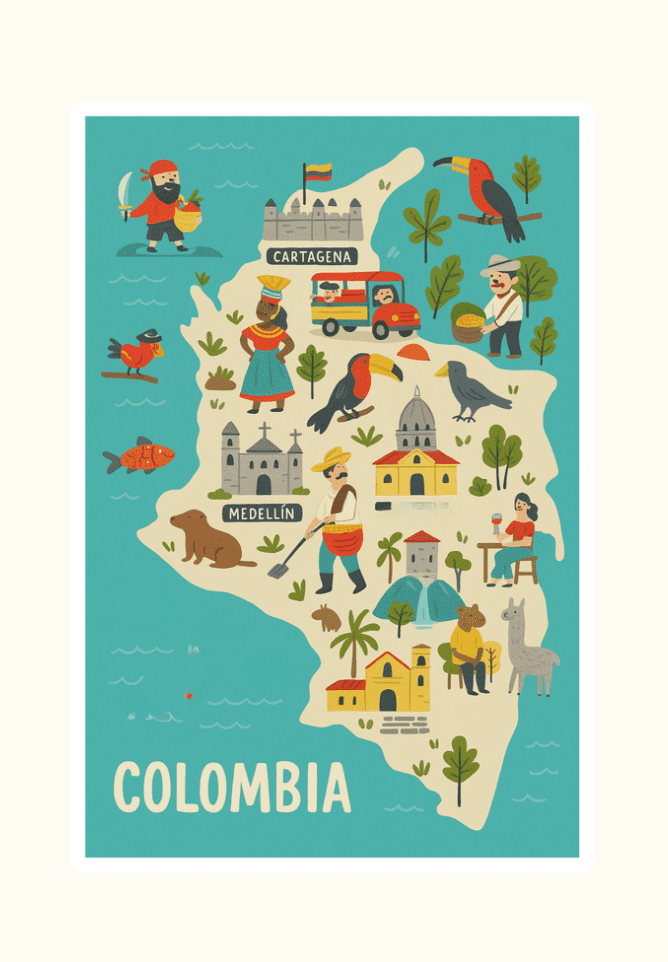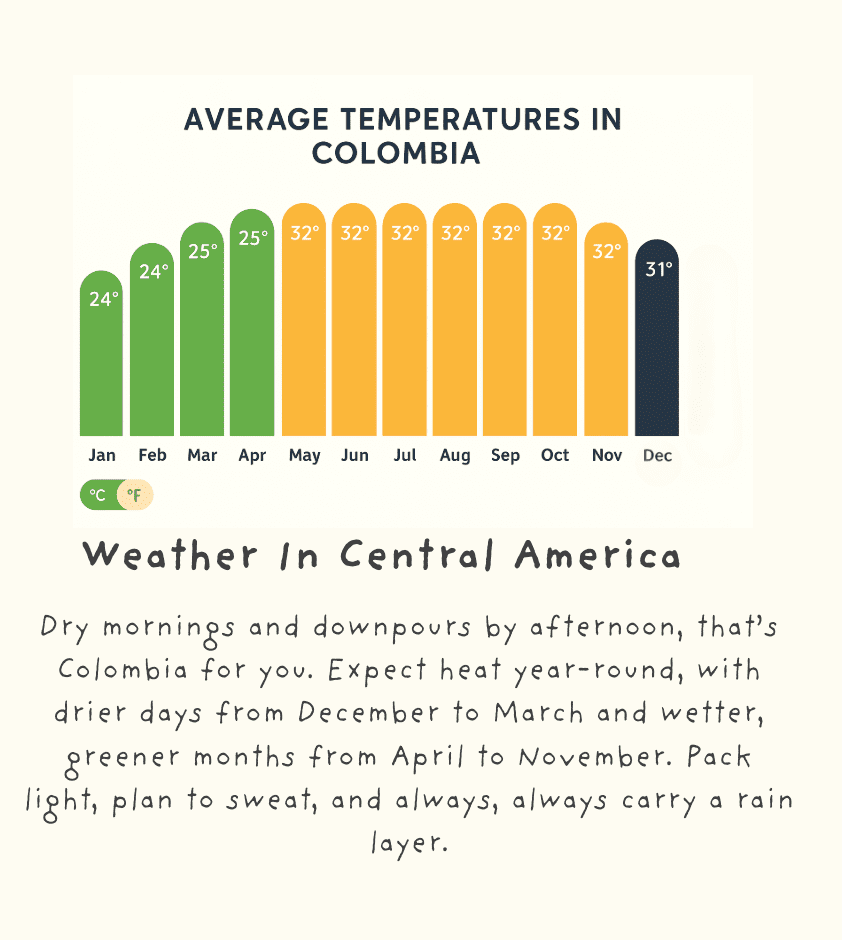BOGOTA
COP
$400 – $1000
Tropical and highlands


Yes — Colombia is vibrant, welcoming, and full of kid-friendly experiences. From colourful towns and jungle cable cars to beach days and cultural festivals, there’s plenty to do as a family. Just be mindful of safety tips, local transport quirks, and choosing the right regions.
Regions like the Coffee Triangle, Cartagena’s walled city, and parts of Medellín (like El Poblado) are considered safe and family-friendly. Always check current advice, stay in well-reviewed areas, and use common sense just like you would anywhere else.
For a family of four, a realistic budget really depend if you’re living or holidaying, if holidaying then around $1,000–$1,500 USD per week, depending on your pace and where you go. That covers food, lodging, local transport, and basic outings. Big-ticket extras like the Rosario Islands or private tours will increase that.
December to March is generally driest and most travel-friendly, especially for beach and outdoor activities. But Colombia’s climate varies by region — Bogotá stays cool year-round, while the coast is hot and humid. You’ll want to pack for both.
Colombia doesn’t follow the typical four-season model — it’s more of a patchwork: dry mornings, humid coastlines, and rainy mountain afternoons.
If you’re planning a trip with kids, especially long-term, understanding Colombia’s weather zones will save you from soggy trainers, underdressed toddlers, or packing five types of jackets. Here’s what to expect — and how to prepare for it, region by region.
For most families, the best time to visit is December through March — known as the “dry season” across many parts of the country.
☀️ These months are:
Drier on the Caribbean coast (Cartagena, Santa Marta)
A bit clearer in the Andes (Bogotá, Medellín)
Ideal for jungle excursions without constant downpours
But even in “dry” months, Colombia’s climate throws surprises. Think sunny mornings and rain by 3pm. If you’re coming from a place with predictable weather patterns, reset those expectations now, it’ll make the adventure more fun.
Planning tip: If you’re slow traveling, consider splitting time between climate zones (e.g. coastal in Jan–Feb, temperate Andes in March–April) to balance the heat.
Colombia is a land of microclimates. Altitude matters more than latitude — and the weather can change fast depending on how high you go.
Tierra Caliente (Hot Land)
Includes: Cartagena, Santa Marta, the Amazon, lowland jungle
Climate: Tropical. It’s hot and humid year-round.
Average temps: 29–32°C (84–89°F)
Travel tip: Days can feel long and sticky. Schedule outings early morning or late afternoon with kids.
Tierra Templada (Temperate Land)
Includes: Medellín, Coffee Triangle
Climate: Spring-like — warm days, cool evenings
Average temps: 18–24°C (64–75°F)
Travel tip: Great for families adjusting to long-term travel. Comfortably warm without the extremes.
Tierra Fría (Cold Land)
Includes: Bogotá, parts of high-altitude countryside
Climate: Cool, with more consistent rain
Average temps: 10–17°C (50–63°F)
Travel tip: Bogotá is safe and cosmopolitan, but it’s not flip-flop weather — bring warm layers and waterproof gear.
Yes — especially in April–May and October–November, which are considered the wettest periods.
🌦️ Rain patterns:
Andes: More mist and drizzle than downpours
Amazon: Heavy rain year-round
Pacific Coast: One of the rainiest places in the world — not ideal for most family travel
Caribbean Coast: Shorter bursts of rain, especially outside dry season
Rain timing: Midday or afternoon rain is super common. Plan outdoor activities early and expect wet ground by 4pm.
$2,000 is a solid starting point for a week-long trip and goes further here than in many other destinations.
Here’s a rough breakdown for a family of four:
Domestic flights: $100–$150 per person if booked early
Accommodation: $40–$100 per night (mid-range Airbnb or hotels)
Food: $20–$40 per day for family meals at local restaurants
Activities: Free city walking tours, museums ($2–$5 entry), day trips from $30
💡 Bonus tip: Avoid peak dates like Semana Santa (Holy Week) or New Year’s, prices jump and availability drops fast.
Here’s your realistic, not-too-minimalist, family-friendly packing list, broken down by climate.
For the Coast & Jungle:
Breathable clothes (quick-dry shirts, loose shorts)
Sandals or water shoes
UV rash guards for kids
Mosquito repellent (natural and DEET-based)
Small waterproof bags for phones/valuables
For the Andes (Bogotá, Medellín):
Layered outfits: T-shirt + jumper + light waterproof jacket
Closed-toe shoes or walking trainers
A scarf or lightweight gloves (yes, even in “warm” cities)
For All Regions:
Microfibre towel
Collapsible water bottle with filter
Compact rain poncho for everyone
Travel first aid kit (especially for bug bites & upset tummies)
Real talk: You don’t need 10 outfits per kid. You do need extra socks, at least one backup favourite T-shirt, and something comforting from home.
Stormy weather can cause transit delays or rough boat rides — not ideal with little ones
Flash floods in jungle regions aren’t common, but can affect tour access
Altitude sickness is real — Bogotá sits at 2,600m+ (8,530 ft). Go slow on arrival, drink water, and rest as needed
Always check local forecasts and ask hosts or tour guides, they’ll know the real-time conditions best.
Colombia isn’t a one-bag-fits-all destination. But it is doable with kids, if you plan by region, not just month. Whether you’re beach-hopping in Santa Marta or ziplining in Salento, weather doesn’t have to be the wildcard that ruins your rhythm.
So yes — pack the layers. Bring the poncho. Expect heat and elevation.
And if you’re not sure what to bring?
We’ve built a Colombia family packing checklist based on all the mistakes we made while test-packing for our own trip.
Colombia doesn’t follow the typical four-season model — it’s more of a patchwork: dry mornings, humid coastlines, and rainy mountain afternoons.
If you’re planning a trip with kids, especially long-term, understanding Colombia’s weather zones will save you from soggy trainers, underdressed toddlers, or packing five types of jackets. Here’s what to expect — and how to prepare for it, region by region.
For most families, the best time to visit is December through March — known as the “dry season” across many parts of the country.
☀️ These months are:
Drier on the Caribbean coast (Cartagena, Santa Marta)
A bit clearer in the Andes (Bogotá, Medellín)
Ideal for jungle excursions without constant downpours
But even in “dry” months, Colombia’s climate throws surprises. Think sunny mornings and rain by 3pm. If you’re coming from a place with predictable weather patterns, reset those expectations now, it’ll make the adventure more fun.
Planning tip: If you’re slow traveling, consider splitting time between climate zones (e.g. coastal in Jan–Feb, temperate Andes in March–April) to balance the heat.
Colombia is a land of microclimates. Altitude matters more than latitude — and the weather can change fast depending on how high you go.
Tierra Caliente (Hot Land)
Includes: Cartagena, Santa Marta, the Amazon, lowland jungle
Climate: Tropical. It’s hot and humid year-round.
Average temps: 29–32°C (84–89°F)
Travel tip: Days can feel long and sticky. Schedule outings early morning or late afternoon with kids.
Tierra Templada (Temperate Land)
Includes: Medellín, Coffee Triangle
Climate: Spring-like — warm days, cool evenings
Average temps: 18–24°C (64–75°F)
Travel tip: Great for families adjusting to long-term travel. Comfortably warm without the extremes.
Tierra Fría (Cold Land)
Includes: Bogotá, parts of high-altitude countryside
Climate: Cool, with more consistent rain
Average temps: 10–17°C (50–63°F)
Travel tip: Bogotá is safe and cosmopolitan, but it’s not flip-flop weather — bring warm layers and waterproof gear.
Yes — especially in April–May and October–November, which are considered the wettest periods.
🌦️ Rain patterns:
Andes: More mist and drizzle than downpours
Amazon: Heavy rain year-round
Pacific Coast: One of the rainiest places in the world — not ideal for most family travel
Caribbean Coast: Shorter bursts of rain, especially outside dry season
Rain timing: Midday or afternoon rain is super common. Plan outdoor activities early and expect wet ground by 4pm.
$2,000 is a solid starting point for a week-long trip and goes further here than in many other destinations.
Here’s a rough breakdown for a family of four:
Domestic flights: $100–$150 per person if booked early
Accommodation: $40–$100 per night (mid-range Airbnb or hotels)
Food: $20–$40 per day for family meals at local restaurants
Activities: Free city walking tours, museums ($2–$5 entry), day trips from $30
💡 Bonus tip: Avoid peak dates like Semana Santa (Holy Week) or New Year’s, prices jump and availability drops fast.
Here’s your realistic, not-too-minimalist, family-friendly packing list, broken down by climate.
For the Coast & Jungle:
Breathable clothes (quick-dry shirts, loose shorts)
Sandals or water shoes
UV rash guards for kids
Mosquito repellent (natural and DEET-based)
Small waterproof bags for phones/valuables
For the Andes (Bogotá, Medellín):
Layered outfits: T-shirt + jumper + light waterproof jacket
Closed-toe shoes or walking trainers
A scarf or lightweight gloves (yes, even in “warm” cities)
For All Regions:
Microfibre towel
Collapsible water bottle with filter
Compact rain poncho for everyone
Travel first aid kit (especially for bug bites & upset tummies)
Real talk: You don’t need 10 outfits per kid. You do need extra socks, at least one backup favourite T-shirt, and something comforting from home.
Stormy weather can cause transit delays or rough boat rides — not ideal with little ones
Flash floods in jungle regions aren’t common, but can affect tour access
Altitude sickness is real — Bogotá sits at 2,600m+ (8,530 ft). Go slow on arrival, drink water, and rest as needed
Always check local forecasts and ask hosts or tour guides, they’ll know the real-time conditions best.
Colombia isn’t a one-bag-fits-all destination. But it is doable with kids, if you plan by region, not just month. Whether you’re beach-hopping in Santa Marta or ziplining in Salento, weather doesn’t have to be the wildcard that ruins your rhythm.
So yes — pack the layers. Bring the poncho. Expect heat and elevation.
And if you’re not sure what to bring?
We’ve built a Colombia family packing checklist based on all the mistakes we made while test-packing for our own trip.
Hi, we’re TravelVentureFour a not-so-ordinary family of four getting ready to swap routines for backpacks and Netflix nights for jungle hikes. We’re Sean, Tania, Atticus (7), and Aurelia (5), and in August 2025, we’re heading off on a year(ish) of slow travel through South and Central America. No trust funds here, just big dreams, small backpacks, and a whole lot of figuring it out as we go. Join us as we prep, learn, laugh, and probably get lost… a lot.
© 2025 Travel Venture Four. Inspiring family adventures across South America.